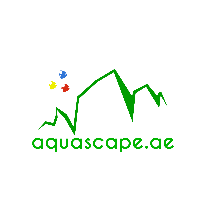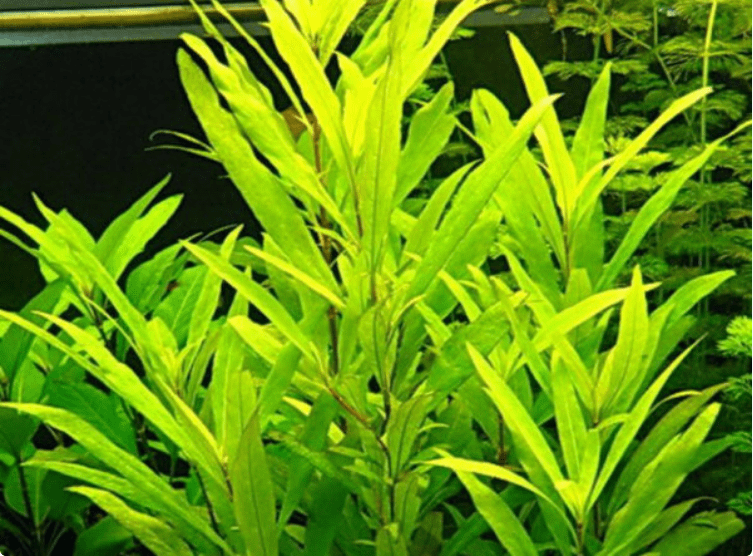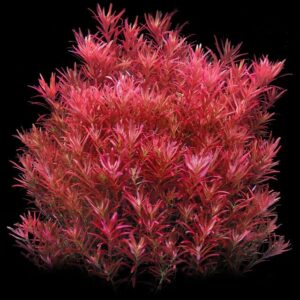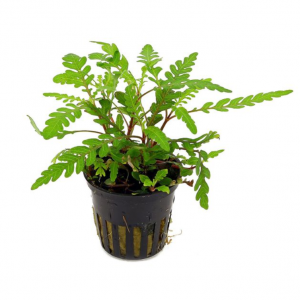Hygrophila Angustifolia
Hygrophila angustifolia (Willow Hygro or Narrowleaf Hygrophila) is a popular aquatic plant in the aquarium hobby due to its attractive appearance and relatively easy care. Here are some tips and care guidelines to help you grow and maintain this plant successfully:
1. Lighting Requirements
- Moderate to High Light: Hygrophila angustifolia thrives under moderate to high lighting conditions.
- Light Duration: Provide 8-10 hours of light per day to promote healthy growth.
- Low Light Adaptation: While it can survive in low light, growth will be slower, and the plant may become leggy or lose its vibrant color.
2. Water Parameters
- Temperature: Keep the water temperature between 22-28°C (72-82°F).
- pH Level: Prefers slightly acidic to neutral water with a pH of 6.0-7.5.
- Water Hardness: Can tolerate a wide range of water hardness but thrives in soft to moderately hard water (2-15 dGH).
3. Substrate and Fertilization
- Nutrient-Rich Substrate: Use a nutrient-rich substrate to support root growth. If using inert substrates like sand or gravel, supplement with root tabs.
- Liquid Fertilizers: Regularly dose a comprehensive liquid fertilizer to provide essential nutrients like nitrogen, phosphorus, potassium, and micronutrients (iron, magnesium, etc.).
- CO2 Supplementation: While not mandatory, CO2 injection can significantly enhance growth and overall health, especially in high-light setups.
د.إ25.00
CompareHygrophila angustifolia, commonly known as Willow Hygro or Narrowleaf Hygrophila, is an aquatic plant belonging to the family Acanthaceae. It is popular in the aquarium trade due to its attractive appearance and relatively easy care requirements. Below is a detailed description of the plant:
General Description:
- Growth Form: Hygrophila angustifolia is a stem plant that grows upright, making it suitable for background or midground placement in aquariums.
- Height: It can grow up to 20-50 cm (8-20 inches) in height, depending on conditions.
- Growth Rate: This plant has a moderate to fast growth rate, especially under optimal conditions.
Leaves:
- Shape: The leaves are long and narrow, resembling willow leaves, which is why it is often called Willow Hygro.
- Size: Leaves can grow up to 10-15 cm (4-6 inches) in length and about 1-2 cm (0.4-0.8 inches) in width.
- Color: The leaves are typically bright green, but under high light and nutrient-rich conditions, they may develop a slightly reddish or brownish tint.
- Arrangement: Leaves are arranged in opposite pairs along the stem.
Stem:
- The stem is slender and green, becoming slightly woody as the plant matures.
- It is brittle, so care should be taken when handling or trimming.
Roots:
- Hygrophila angustifolia develops a fibrous root system that anchors it in the substrate.
- It can also produce adventitious roots along the stem, especially if planted in shallow water or emersed conditions.
Flowers:
- In its natural habitat or when grown emersed, Hygrophila angustifolia can produce small, pale blue or white flowers.
- The flowers are tubular and grow in clusters at the leaf axils.
Habitat:
- Native Range: This plant is native to Southeast Asia, including countries like India, Malaysia, and Indonesia.
- Environment: It thrives in wetlands, marshes, and along riverbanks, often growing partially submerged or fully submerged in slow-moving water.
Aquarium Care:
- Lighting: Moderate to high lighting is ideal for optimal growth and coloration.
- Water Parameters: Prefers slightly acidic to neutral pH (6.0-7.5) and a temperature range of 22-28°C (72-82°F).
- Substrate: A nutrient-rich substrate is beneficial, but it can also grow in sand or gravel if supplemented with root tabs or liquid fertilizers.
- CO2: While not strictly necessary, CO2 supplementation can enhance growth and overall health.
- Propagation: Easily propagated by stem cuttings. Simply cut a healthy stem and replant it in the substrate.
Uses in Aquascaping:
- Background Plant: Its tall, upright growth makes it ideal for the background of aquariums.
- Midground Plant: When trimmed regularly, it can be used as a midground plant to create a bushy, dense appearance.
- Natural Look: Its narrow leaves provide a delicate, natural look, contrasting well with broader-leaved plants.
Challenges:
- Pruning: Regular pruning is necessary to prevent it from overshadowing other plants.
- Nutrient Demand: It can be a heavy feeder, so ensure adequate nutrients are available to prevent deficiencies.
Overall, Hygrophila angustifolia is a versatile and attractive plant that can enhance the aesthetics of an aquarium while providing benefits such as oxygenation and habitat for aquatic life.






